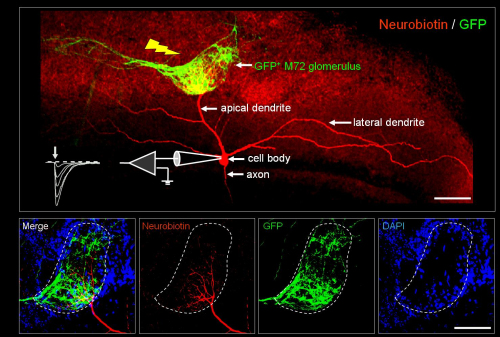A Study Reveals A Secret of Memory Formation in the Brain
In the romantic movie 50 first dates, Lucy gets up every morning without remembering anything that happened to her yesterday. She has this memory-loss problem since she experienced a car accident.
Learning and memory is probably the most intriguing topic in brain science. In a new study published on July 5 in Neuron, a research group led by Professor CAO Peng of the Institute of Biophysics, Chinese Academy of Sciences, has made major progress in this field.
In the very famous Hebbian theory, Dr. Donald Hebb proposed that the brain learns new tasks or skills by modifying the efficacy of synaptic junctions between individual neurons. Although many studies have supported this “Memory-Synapse Specificity” Hypothesis, the direct evidence was still lacking. In this study, Professor CAO Peng’s group has provided a direct experimental evidence for the “Memory-Synapse Specificity” Hypothesis.
They show that socially acquired olfactory memory is associated with a synaptic long-term potentiation (LTP) event that occurs at a specific type of synapses on identified olfactory bulb neurons within a particular glomerular unit (Figure 1). Such LTP lasts at least two weeks! By genetically manipulating machinery for IGF1 exocytosis, they further describe a detailed signaling pathway that mediates this novel form of LTP which had not been identified previously. Moreover, they show that this type of LTP is essential for olfactory memory but not for odor perception as such, demonstrating that this LTP encodes, at least in part, socially acquired olfactory memory.

Figure 1. A genetically identified olfactory bulb neuron was examined by patch clamp whole-cell recording after mouse olfactory learning.(Image by IBP)
Testing and validating the “Memory-Synapse Specificity” Hypothesis has constituted a persistent challenge in brain sciences because it was not possible to link a specific type of synapses to a particular behavior and memory. Professor CAO Peng’s Group achieved this goal by exploiting the exquisite microcircuits in the olfactory bulb, and making use of the availability of mice in which olfactory circuits associated with a specific odor can be visually identified. It is the first demonstration that long-term potentiation at a particular type of synapses in an identified circuit encodes a defined memory.
People are still having many questions about learning and memory to answer. Where is memory formed and stored in the brain? How does memory loss happen after an accident, like that in movie 50 first dates, or after Alzheimer’s disease? Professor CAO’s study may provide a new starting point to investigate these intriguing and fundamental scientific questions.
Contact
CAO Peng
State Key Laboratory of Brain & Cognitive Sciences
Institute of Biophysics
Email:caopeng@nibs.ac.cn;pcao@ibp.ac.cn
Tel: 86-10-64888528

